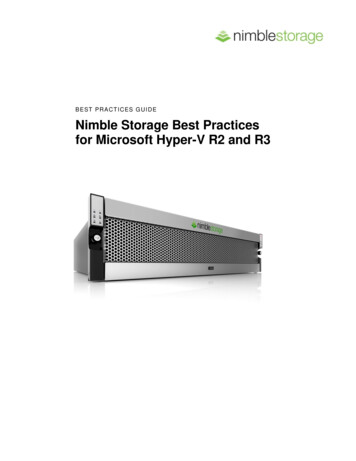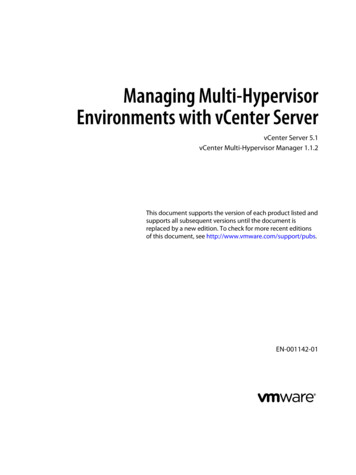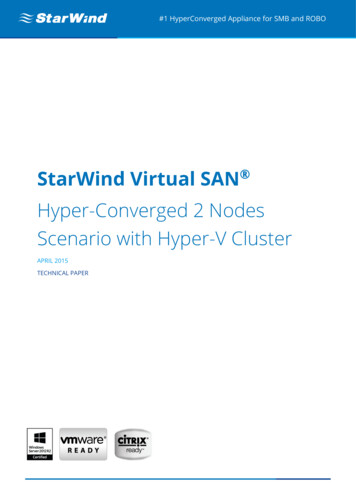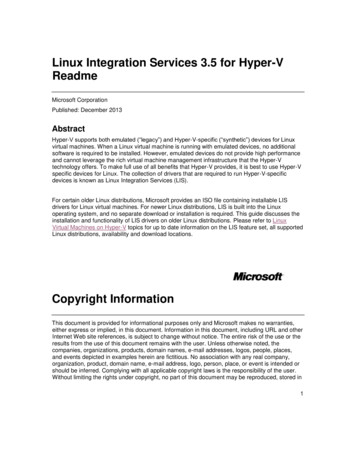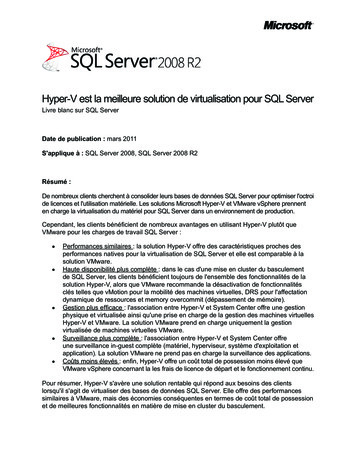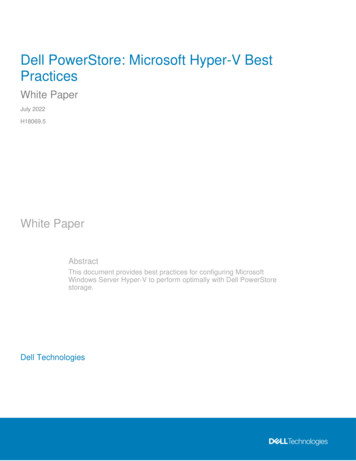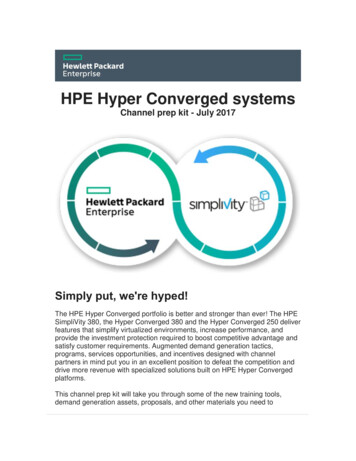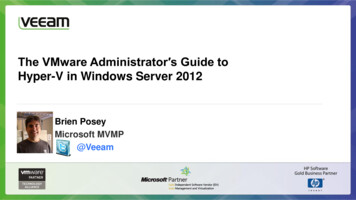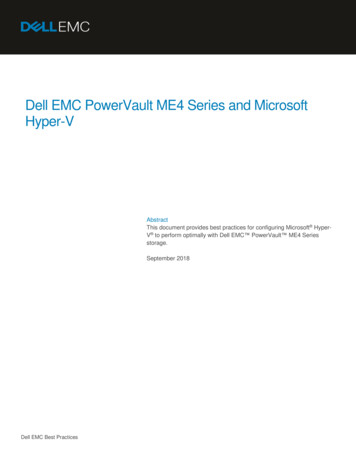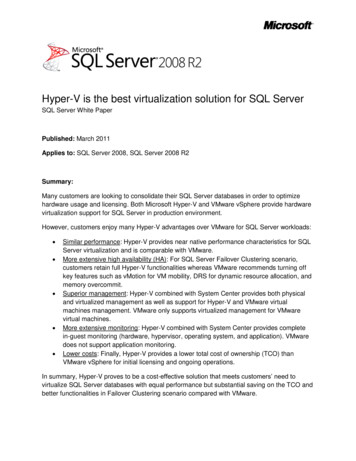
Transcription
Hyper-V is the best virtualization solution for SQL ServerSQL Server White PaperPublished: March 2011Applies to: SQL Server 2008, SQL Server 2008 R2Summary:Many customers are looking to consolidate their SQL Server databases in order to optimizehardware usage and licensing. Both Microsoft Hyper-V and VMware vSphere provide hardwarevirtualization support for SQL Server in production environment.However, customers enjoy many Hyper-V advantages over VMware for SQL Server workloads: Similar performance: Hyper-V provides near native performance characteristics for SQLServer virtualization and is comparable with VMware.More extensive high availability (HA): For SQL Server Failover Clustering scenario,customers retain full Hyper-V functionalities whereas VMware recommends turning offkey features such as vMotion for VM mobility, DRS for dynamic resource allocation, andmemory overcommit.Superior management: Hyper-V combined with System Center provides both physicaland virtualized management as well as support for Hyper-V and VMware virtualmachines management. VMware only supports virtualized management for VMwarevirtual machines.More extensive monitoring: Hyper-V combined with System Center provides completein-guest monitoring (hardware, hypervisor, operating system, and application). VMwaredoes not support application monitoring.Lower costs: Finally, Hyper-V provides a lower total cost of ownership (TCO) thanVMware vSphere for initial licensing and ongoing operations.In summary, Hyper-V proves to be a cost-effective solution that meets customers’ need tovirtualize SQL Server databases with equal performance but substantial saving on the TCO andbetter functionalities in Failover Clustering scenario compared with VMware.
Hyper-V is the best virtualization solution for SQL ServerThe following table shows the comparison from Hyper-V and VMware; these are covered inmore detail in this paper.FeaturesMicrosoft Hyper-VVMwareNear Native PerformanceFull support for SQL Server FailoverClusteringPhysical and Virtual Management for1Hyper-V and VMware virtual machinesIn-guest Monitoring1Lower Total Cost of Ownership (TCO)1Microsoft Hyper-V and System CenterMany customers understand the benefits outlined in the summary and table above. To realizethose benefits, they have chosen to run their SQL Server using Hyper-V or have switched theirexisting SQL Server to Hyper-V from VMware. More details on their benefits can be obtainedthrough these case studies.2
Hyper-V is the best virtualization solution for SQL Server 2011 Microsoft Corporation. All rights reserved. This document is provided "as-is." Informationand views expressed in this document, including URL and other Internet Web site references,may change without notice. You bear the risk of using it.This document does not provide you with any legal rights to any intellectual property in anyMicrosoft product. You may copy and use this document for your internal, reference purposes.3
Hyper-V is the best virtualization solution for SQL ServerContentsIntroduction and Overview . 4Performance . 4High Availability Scenario . 5Management . 6Monitoring . 7Total Cost of Ownership . 7Customer Case Studies . 8Conclusion .10Introduction and OverviewCustomers continuously find a new way to optimize their datacenter usage throughconsolidation. Over the last several years, virtualization is becoming one of the most popularways to get more out of the hardware resources. Virtualization also provides additional benefitssuch as the ability to reduce power consumption, gain operational agility, and increaseapplication availability. Microsoft Hyper-V and VMware provide hypervisors to do hardwarevirtualization. Hyper-V is an optimal virtualization platform to use for deploying demanding andmission critical production applications including Microsoft SQL Server database workloads.SQL Server is a complete set of enterprise-ready technologies and tools that help customersderive the most value from information at the lowest total-cost-of-ownership. In fact, accordingto IDC, SQL Server is the fastest growing database and business intelligence vendor and shipsmore units than its competitors Oracle and IBM DB2. Microsoft supports SQL Server running invirtualized environment for Hyper-V and non-Microsoft hypervisors. This paper shows thebenefits of SQL Server on Hyper-V over VMware hypervisor.PerformanceWith Hyper-V, multiple virtual instances running SQL Server OLTP and OLAP workloads canachieve essentially the same throughput and performance as running in physical environment.Hyper-V features are able to take full advantage of advanced virtualization technologies on thelatest server processors such as hardware second level address translation (SLAT). AMDdescribes its SLAT technology as AMD Virtualization (AMD-V ) Rapid Virtualization Indexing(RVI) or nested paging tables (NPT). Intel describes their SLAT technology as Intel Virtualization- Extended Page Tables (VT-EPT). Current servers equipped with the latest processors fromIntel or AMD not only provide hardware assisted virtualization; they also perform virtual memorymanagement and other functions that were traditionally fulfilled by the hypervisor. This capabilitysubstantially benefits the workload because it improves overall system performance. Hyper-V4
Hyper-V is the best virtualization solution for SQL Servertakes full advantage of these hardware features to produce close to native performance ofvirtual SQL Server instances.More details on SQL Server performance on Hyper-V can be obtained through these whitepapers: High Performance SQL Server Workloads on Hyper-V and Running SQL Server 2008 inHyper-V environment Best Practice and Performance.High Availability ScenarioTo support “24x7” availability of their mission critical applications, many companies require theirSQL Server database to be available virtually all of the time, with system downtime kept to anabsolute minimum.Failover clustering is the only approach that enables an entire SQL Server instance to be madehighly available – either at the local data center or possibly at a remote site or data center. ASQL Server failover cluster relies on the broadly adopted Windows Server Cluster technology.SQL Server customers prefer failover clustering to make sure database instances are highlyavailable especially for mission critical applications. More SQL Server customers implementedfailover clustering over other high availability technologies such as database mirroring. Becauseof its popularity and high preference, the next version of SQL Server codename “Denali” willmake use of Windows Clustering as the base technology for AlwaysOn, its new high availabilitysolution that is flexible, interoperable, and efficient.VMware placed many restrictions on its features for SQL Server failover clustering. The detailsof these restrictions are outlined in page 11 and 34 of VMware white paper Setup for FailoverClustering and Microsoft Cluster Service for the latest versions of VMware ESX 4.1, ESXi 4.1,and vCenter Server 4.1.Page 11 of VMware paper mentions a list of functions that are not supported for MicrosoftCluster Services (MSCS). Clustering on iSCSI, FCoE, and NFS disks.Mixed environments, such as configurations where one cluster node is running adifferent version of ESX/ESXi than another cluster node.Use of MSCS in conjunction with VMware Fault Tolerance.Migration with vMotion of clustered virtual machines.N-Port ID Virtualization (NPIV)With native multipathing (NMP), clustering is not supported when the path policy is set toround robin.You must use hardware version 7 with ESX/ESXi 4.1.Page 34 of VMware paper recommends not to use memory overcommit.5
Hyper-V is the best virtualization solution for SQL ServerIn summary, customers who are using failover clustering on VMware will lose the following: No VM mobility because vMotion is not supported. vMotion is a VMware technology thatenables virtual machines to be migrated live from server to server. This is a substantialrestriction as it is one of the key reasons and benefits of hardware virtualization.No dynamic resource allocation because Dynamic Resource Scheduler (DRS) is notsupported. DRS is a VMware technology that monitor resource pool utilization andintelligently load balance virtual machines to obtain optimum resource pool usage.No virtual SAN because N-Port ID Virtualization (NPIV) is not supported. NPIV allowsmultiple fiber channels to occupy a single physical port in Storage Area Network (SAN)storage.No zero loss protection because VMware Fault Tolerance is not supported.Less flexibility and performance because memory overcommit is not recommended.Memory overcommit is a VMware feature that can identify idle memory and dynamicallyreallocate unused memory from some VMs to others that need more memory.On the other hand, Hyper-V provides better features compared to VMware for SQL Serverrunning in failover clustering scenario and customers retain all Hyper-V advanced features: Live Migration. It is a Hyper-V technology that allows a server administrator to move arunning virtual machine or application between different physical machines withoutdisconnecting the client or application.Mixed guest/host cluster configuration. It is having both physical and virtual nodes in thesame cluster.Dynamic memory. It is a Hyper-V technology that allows the memory assigned to guestvirtual machines to vary according to demand.N-Port ID Virtualization (NPIV) support through System Center Virtual MachineManager. NPIV allows multiple fiber channels to occupy a single physical port in StorageArea Network (SAN) storage.ManagementVirtual machines are not simply objects to manipulate, but actual computers with real workloads.It is imperative to manage virtual machines the same way as managing physical systems.System Center Management Suite Datacenter (SMSD) provides a comprehensive set ofintegrated management tools for physical and virtual machines. Customers can keep complexityat a minimum and streamline operations with a common management environment that reducestraining, ensures uniform policy application, and simplifies maintenance by utilizing existingsoftware, personnel, and most importantly, existing IT management process.More details on System Center management can be obtained through this site.On the other hand, VMware does not provide physical system management as it only focuseson virtualization management on virtual machines and hypervisor host.6
Hyper-V is the best virtualization solution for SQL ServerMonitoringAs organizations incorporate virtualization into their IT services infrastructure, they have accessto new capabilities that can increase efficiency, flexibility, and application uptime. IT servicesinfrastructure can be categorized into the following layers: hardware, hypervisor, operatingsystem, and application. The hardware layer includes server, networking, and storage. Thehypervisor layer includes events, configuration, and performance data related to hypervisorsuch as Hyper-V. The operating system layer includes Windows Server and other operatingsystems. And the application layer includes events, configuration, and performance data relatedto applications like SQL Server, or line of business (LOB) applications built on SQL Server.To fully benefit from these new capabilities, customers require monitoring software that fullyintegrates virtualization capabilities that include in-guest monitoring capabilities. Monitoringsoftware that does not combine information about hardware, hypervisor, operating system, andapplications into a single console, or that shows causal relationships between components, willbe less effective in helping IT staff both respond to service interruptions quickly and maximizedatacenter efficiency. In particular, monitoring and management software that does not havedeep visibility into the application layer will be missing vital information that could otherwise helpmaximize uptime. Monitoring tools that only inspect the operating system and hypervisor layerscan miss vital application-layer warnings that can quickly escalate into service outages thateffect users.System Center in-guest monitoring combines visibility into the hardware, hypervisor, operatingsystem, and applications layer with a single console interface that illustrates relationshipsbetween layers of the IT infrastructure, along with insight into end-user experiences or systemrelated transactions, to help IT staff maximize both uptime and datacenter efficiency.On the other hand, VMware vCenter does not provide deep visibility into the applicationsrunning within VMs. VMware’s monitoring tool vCenter lacks in-guest monitoring capabilities.Instead, vCenter relies on packet inspection of network data to and from applications runningwithin a VM. In addition, vCenter does not gather information directly from applications. WhilevCenter does gather information about current application performance, throughput, andlatency, vCenter does not have visibility into many in-guest conditions that ultimately lead to anapplication outage.System Center fully integrates virtualization monitoring and management into existingmonitoring capabilities. With System Center, organizations gain the ability to fully integratevirtualization as a core capability in a dynamic, self-managing IT services infrastructure.More details on System Center monitoring can be obtained through this white paper: In-GuestMonitoring with System Center.Total Cost of OwnershipUnderstanding the costs of licensing and ongoing operational allows customers to make a moreinformed decision when deciding which hypervisor is best for their organization. There aresubstantial functionality and price differences between these two solutions. In general, VMware7
Hyper-V is the best virtualization solution for SQL Serverapproaches virtualization as a niche infrastructure addition while Microsoft approachesvirtualization as an integrated infrastructure commodity.While both Microsoft and VMware’s pricing structure causes overall solution price to scale withthe number of servers used, VMware’s pricing structure simply charges more for less overallfunctionality. By virtualizing with Microsoft solutions, customers save up to one-third the cost ofa comparable VMware solution2. With the greater functionality of System Center, including theonly solution for in-guest management and automated VM optimization using in-guestknowledge, the Microsoft solution provides more value in scenarios from five servers all the waythrough to large enterprise deployments of 200 servers or more. This makes Microsoft the bettervalue for organizations of any size.More details on licensing cost comparison between Hyper-V and VMware can be obtainedthrough this white paper: Cutting Costs with Microsoft Virtualization and this site.While Microsoft provides better value than VMware for initial licensing cost, research also showsthat customers running Hyper-V spend 24% less on IT labor, on an ongoing basis, thancustomers using either VMware ESX or vSphere. More details on ongoing operation costcomparison between Hyper-V and VMware can be obtained through this white paper: MicrosoftHyper-V vs. VMware ESX & vSphere: Operations & Management Cost Analysis.Customer Case StudiesMicrosoft virtualization saves customers significantly more money and enables greater agilitythan VMware, while providing the key capabilities they need and enabling them to utilize theexpertise they already have from using other Microsoft products. Companies with existingVMware who are starting to look for tangible, bottom-line benefits from virtualization put cost atthe top of their list. That’s why, when organizations want to expand the initial virtualizationenvironments they built using VMware into larger-scale implementations, many of them move toMicrosoft.Following table is a sampling of SQL Server customers that have chosen Microsoft virtualizationover VMware.CustomerUniversity ofWaterlooFpweb.netAyala8IndustryLocationIn Their Own Words“We’re now cost-effectively operating within a more virtualized ITEducationCanadaenvironment with Hyper-V – especially when compared to how muchwe estimate it would have cost to run VMware in the same capacity.”SaaSUnited StatesProfessionalPhilippinesServices“With VMware, we would face an up-front licensing cost of 100,800,which would force us to increase our pricing. By comparison, when welicensed Windows Server 2008 Enterprise, Hyper-V was included forfree.”“Even after VMware cut its costs to be more competitive, we were stillable to realize a more cost-effective solution with Microsoft by using
Hyper-V is the best virtualization solution for SQL Serverthe Windows Server 2008 Datacenter edition.”“We’ve been happy with the overall performance and reliability ofHyper-V and the cost for Hyper-V servers is much less than it is forphysical hardware, which helps our bottom line.”1800GOTJUNKServicesCanadaLee CompanyConstructionsUnited States“By deploying Hyper-V instead of VMware, we saved about 15,000 inlicensing fees.”BankingUnited States“Sure, it was a lot cheaper to go with Hyper-V. But that was a sidebenefit; we went with it because it’s the better virtualization solution.”Morocco“Compared with other virtualization suppliers in Morocco, Microsoftprovides us with peace of mind. We can plan for the future and deploynew applications knowing that our systems will expand cost-effectivelyto meet demand”Urban LendingSolutionsLa Directiondes DomainesGovernmentde l'EtatFollowing table is a sampling of SQL Server customers that have switched from VMware toMicrosoft virtualization.CustomerCH2M HILLUnion ion,LogisticsLocationIn Their Own Words“The company was cutting costs across the board, and we wanted toUnited Statespush forward with virtualizing more servers, especially in our fieldoffices, but we just couldn’t do it with VMware.”“We would not have been able to proceed as aggressively withUnited Statesvirtualizing our Windows production workloads without the move toHyper-V.”“With Hyper-V, Apps4Rent has a competitive advantage. Using aApps4RentSaaSUnited StatesMicrosoft virtualization solution, we can serve more customers moreefficiently and cost effectively than we ever could with VMware”AvanadeCrutchfieldUniversity ofMiamiChildren’sHospitalSwedish RedCross9IT ServicesUnited States“Hyper-V was significantly more cost-effective than those VMwarelicenses we had used for our test and development environment”RetailUnited States“Since deploying Hyper-V, IT has shown a new level of agility andresponsiveness. Thanks to our Microsoft virtualization solution, we aremeeting the needs of the business while minimizing costs”EducationUnited States“Microsoft virtualization solutions cost us 60 percent less thanVMware. They help us save money today while giving us thecapabilities needed to operate even more efficiently and costeffectively as time goes on”HealthcareUnited States“[With System Center and Hyper-V] we can do more with a smallerstaff; plus, we’ve been able to redeploy staff to higher-value projects.”Non-profitSweden“Saving money was certainly part of the appeal of Windows Server2008, but we also knew that with a pure Microsoft solution, we could
Hyper-V is the best virtualization solution for SQL Servermanage our entire infrastructure ourselves and get rid of expensiveVMware consultants”More details on the customers’ benefits from using Hyper-V over VMware can be obtainedthrough these case studies.ConclusionMicrosoft fully supports running SQL Server workloads with Hyper-V. Microsoft Hyper-V hasmany advantages over VMware for SQL Server in the area of performance, full support forFailover Clustering scenario, holistic physical and virtual management, application monitoring,faster to market with appliance, and overall lower TCO for both initial licensing and ongoingmaintenance costs.Hyper-V is a cost-effective solution that meets customers’ need to virtualize SQL Serverdatabases with equal performance but substantial saving on the licensing/ongoing maintenancecosts and better functionalities in Failover Clustering scenario compared with VMware.Many customers understand the benefits of running SQL Server with Hyper-V by choosingHyper-V or migrate from their existing VMware implementation. More details on their benefitscan be obtained through these case studies.For more information: per-vDid this paper help you? Please give us your feedback. Tell us on a scale of 1 (poor) to 5(excellent), how would you rate this paper and why have you given it this rating? For example:Are you rating it high due to having good examples, excellent screen shots, clear writing,or another reason?Are you rating it low due to poor examples, fuzzy screen shots, or unclear writing?This feedback will help us improve the quality of white papers we release.Send feedback.2Based on a server virtualization comparison of Microsoft System Center Server Management Suite Datacenterwith VMware’s vSphere Enterprise Plus with VMware vCenter Server. Cost comparisons assumes a five hostconfiguration, 2 processors on each host, 2 years support costs for both products, and no operating system costsincluded. The Microsoft solution can use either the free Microsoft Hyper-V Server 2008 R2 hypervisor or an existingWindows Server 2008 R2 hypervisor. Based on Microsoft estimated retail prices and published VMware prices as of08/01/2010 for purchases in the United States. Actual reseller prices may vary.10
virtualization support for SQL Server in production environment. However, customers enjoy many Hyper-V advantages over VMware for SQL Server workloads: Similar performance: Hyper-V provides near native performance characteristics for SQL Server virtualization and is comparable with VMware. More extensive high availability (HA): For SQL Server .


